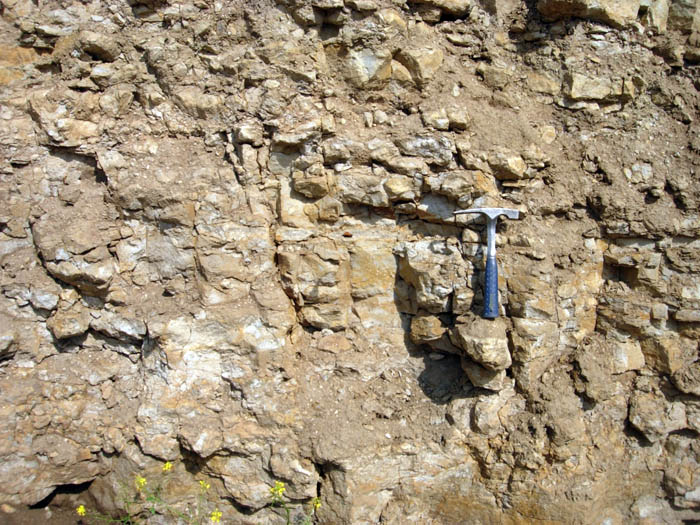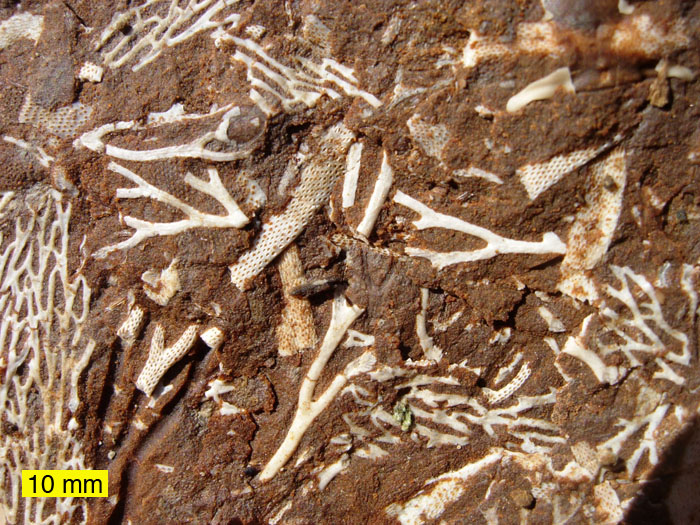|
Kukersite
Kukersite is a light-brown marine type oil shale of Ordovician age. It is found in the Baltic Oil Shale Basin in Estonia and North-West Russia. It is of the lowest Upper Ordovician formation, formed some 460 million years ago. It was named after the German name of the Kukruse Manor in the north-east of Estonia by the Russian paleobotanist Mikhail Zalessky in 1917. Some minor kukersite resources occur in sedimentary basins of Michigan, Illinois, Wisconsin, North Dakota, and Oklahoma in North America and in the Amadeus and Canning basins of Australia. Baltic Oil Shale Basin The Baltic Oil Shale Basin covers about . Main kukersite deposits are Estonian and Tapa deposits in Estonia, and Leningrad deposit in Russia (also known as Gdov or Oudova deposit). Other occurrences in Russia are Veimarn and Chudovo–Babinskoe deposits. The Estonian deposit, which covers about , is exploited industrially; the Tapa deposit is not accounted as reserves due its lower value ... [...More Info...] [...Related Items...] OR: [Wikipedia] [Google] [Baidu] |
Kukruse Manor
Kukruse (german: Kuckers) is a village in Toila Parish, Ida-Viru County in northeastern Estonia. It is located by the Tallinn–Narva road (E20), between the cities of Kohtla-Järve and Jõhvi. Adjacent to the village is a district of Kohtla-Järve sharing the same name, Kukruse. Before the 2017 Administrative Reform, the village belonged to Kohtla Parish. As of 2011 Census, the settlement's population was 52. Kukersite, a marine type oil shale of Ordovician age, is named after Kukruse. During the road construction in 2009, a cemetery approximately 800 years old was revealed. Fifty graves were studied. The human remains and objects placed in the graves provide a good picture of 13th century society, culture and beliefs. Some of the finds from Kukruse were displayed at the Estonian History Museum. Kukruse Manor Kukruse (german: link=no, Kuckers) knight manor was first mentioned in 1453. The present building received its appearance in the 19th century when a second floor wa ... [...More Info...] [...Related Items...] OR: [Wikipedia] [Google] [Baidu] |
Mikhail Zalessky
Mikhail Dmitrievich Zalessky (russian: Михаил Дмитриевич Залесский, ''Mikhail Dmitrievich Zalesskiy''; 15 September 1877 – 22 December 1946) was a Russian paleontologist and paleobotanist. His main focus was an investigation of plant remains in coals and oil shales. In 1911, Zalessky described a new type of petrified wood from the Donets Basin in Ukraine. He called the wood ''Callixylon'', though he did not find any structures other than the trunk. In the 1960s, it was demonstrated that the fossil wood known as ''Callixylon'' and the leaves known as ''Archaeopteris'' were actually part of the same plant. In 1917, he studied kukersite oil shale from Kukruse stage in Estonia. Correspondingly he named that particular oil shale after the German name of the Kukruse manor. Zalessky described oval bodies of kerogen Kerogen is solid, insoluble organic matter in sedimentary rocks. Comprising an estimated 1016 tons of carbon, it is the most abundant sou ... [...More Info...] [...Related Items...] OR: [Wikipedia] [Google] [Baidu] |
Oil Shale
Oil shale is an organic-rich fine-grained sedimentary rock containing kerogen (a solid mixture of organic chemical compounds) from which liquid hydrocarbons can be produced. In addition to kerogen, general composition of oil shales constitutes inorganic substance and bitumens. Based on their deposition environment, oil shales are classified as marine, lacustrine and terrestrial oil shales. Oil shales differ from oil-''bearing'' shales, shale deposits that contain petroleum ( tight oil) that is sometimes produced from drilled wells. Examples of oil-''bearing'' shales are the Bakken Formation, Pierre Shale, Niobrara Formation, and Eagle Ford Formation. Accordingly, shale oil produced from oil shale should not be confused with tight oil, which is also frequently called shale oil. Deposits of oil shale occur around the world, including major deposits in the United States. A 2016 estimate of global deposits set the total world resources of oil shale equivalent of of oil in ... [...More Info...] [...Related Items...] OR: [Wikipedia] [Google] [Baidu] |
Eesti Rahvusringhääling
Eesti Rahvusringhääling (ERR) – ''Estonian Public Broadcasting'' – is a publicly funded and owned radio and television organisation created in Estonia on 1 June 2007 to take over the functions of the formerly separate Eesti Raadio (ER) (''Estonian Radio'') and Eesti Televisioon (ETV) (''Estonian Television''), under the terms of the Estonian National Broadcasting Act. The first chair of ERR is Margus Allikmaa, the former chair of Eesti Raadio. Present CEO is Erik Roose. The organisation has proved popular since its creation, with ETV becoming the national television channel, creating and producing their own shows. Eesti Rahvusringhääling (ERR) can be streamed live from all around the world from online browsers as well as an app. Services Television ERR's three national television channels are: * ETV – a general interest television channel * ETV2 – programming for children, sports, cultural programming, i.e. quality films and drama series * ETV+ &n ... [...More Info...] [...Related Items...] OR: [Wikipedia] [Google] [Baidu] |
Gigajoule
The joule ( , ; symbol: J) is the unit of energy in the International System of Units (SI). It is equal to the amount of work done when a force of 1 newton displaces a mass through a distance of 1 metre in the direction of the force applied. It is also the energy dissipated as heat when an electric current of one ampere passes through a resistance of one ohm for one second. It is named after the English physicist James Prescott Joule (1818–1889). Definition In terms of SI base units and in terms of SI derived units with special names, the joule is defined as One joule can also be defined by any of the following: * The work required to move an electric charge of one coulomb through an electrical potential difference of one volt, or one coulomb-volt (C⋅V). This relationship can be used to define the volt. * The work required to produce one watt of power for one second, or one watt-second (W⋅s) (compare kilowatt-hour, which is 3.6 megajoules). This relationship can ... [...More Info...] [...Related Items...] OR: [Wikipedia] [Google] [Baidu] |
Limestone
Limestone ( calcium carbonate ) is a type of carbonate sedimentary rock which is the main source of the material lime. It is composed mostly of the minerals calcite and aragonite, which are different crystal forms of . Limestone forms when these minerals precipitate out of water containing dissolved calcium. This can take place through both biological and nonbiological processes, though biological processes, such as the accumulation of corals and shells in the sea, have likely been more important for the last 540 million years. Limestone often contains fossils which provide scientists with information on ancient environments and on the evolution of life. About 20% to 25% of sedimentary rock is carbonate rock, and most of this is limestone. The remaining carbonate rock is mostly dolomite, a closely related rock, which contains a high percentage of the mineral dolomite, . ''Magnesian limestone'' is an obsolete and poorly-defined term used variously for dolomite, for lime ... [...More Info...] [...Related Items...] OR: [Wikipedia] [Google] [Baidu] |
Organic Compound
In chemistry, organic compounds are generally any chemical compounds that contain carbon- hydrogen or carbon-carbon bonds. Due to carbon's ability to catenate (form chains with other carbon atoms), millions of organic compounds are known. The study of the properties, reactions, and syntheses of organic compounds comprise the discipline known as organic chemistry. For historical reasons, a few classes of carbon-containing compounds (e.g., carbonate salts and cyanide salts), along with a few other exceptions (e.g., carbon dioxide, hydrogen cyanide), are not classified as organic compounds and are considered inorganic. Other than those just named, little consensus exists among chemists on precisely which carbon-containing compounds are excluded, making any rigorous definition of an organic compound elusive. Although organic compounds make up only a small percentage of Earth's crust, they are of central importance because all known life is based on organic compounds. Livin ... [...More Info...] [...Related Items...] OR: [Wikipedia] [Google] [Baidu] |
Oil Shale Gas
Oil shale gas (also: retort gas or retorting gas) is a synthetic non-condensable gas mixture (syngas) produced by oil shale thermal processing ( pyrolysis). Although often referred to as shale gas, it differs from the natural gas produced from shale, which is also known as shale gas. Process Oil shale gas is produced by retorting (pyrolysis) of oil shale. In the pyrolysis process, oil shale is heated until its kerogen decomposes into vapors of a petroleum-like condensable shale oil, non-condensible combustible oil shale gas, and spent shale—a solid residue. The process is the same as the shale oil extraction and oil shale gas usually occurs as a byproduct of shale oil production. The ratio of oil shale gas to shale oil depends on retorting temperature and as a rule, increases by the rise of temperature. Composition There is no exact formula of oil shale gas. Compositions of oil shale gas depends on the retorted oil shale and exploited technology. Typical compo ... [...More Info...] [...Related Items...] OR: [Wikipedia] [Google] [Baidu] |
International Energy Agency
The International Energy Agency (IEA) is a Paris-based autonomous Intergovernmental organization, intergovernmental organisation, established in 1974, that provides policy recommendations, analysis and data on the entire global energy sector, with a recent focus on curbing carbon emissions and reaching global climate targets, including the Paris Agreement. The 31 member countries and 11 association countries of the IEA represent 75% of global energy demand. The IEA was set up under the framework of the Organisation for Economic Co-operation and Development (OECD) in the aftermath of the 1973 oil crisis to respond to physical disruptions in global oil supplies, provide data and statistics about the global Petroleum industry, oil market and Energy industry, energy sector, promote energy savings and conservation, and establish international technical collaboration on innovation and research. Since its founding, the IEA has also coordinated use of the oil reserves that its members are ... [...More Info...] [...Related Items...] OR: [Wikipedia] [Google] [Baidu] |



